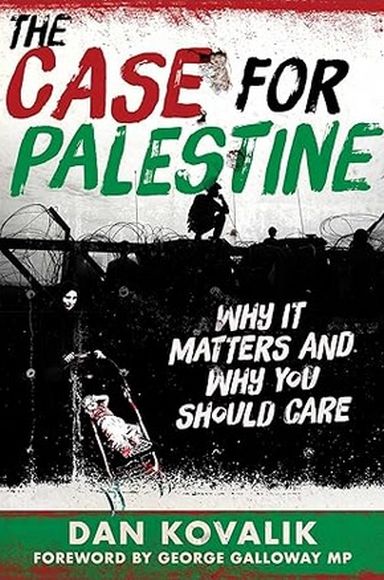

| THE CASE FOR PALESTINE Why It Matters and Why You Should Care Dan Kovalik George Galloway, MP (Foreword) Hot Books, May 2024 |
Rating: 5.0 High |
|||
| ISBN-13 978-1-5107-8059-0 | ||||
| ISBN-10 1-5107-8059-9 | 221pp. | HC | $32.99 | |
Few conflicts have been as intractable as the one between Israel and the Palestinian population of the territory Israel was granted by the British Mandate at the end of World War 1, and after World War 2 and the Holocaust, by the United Nations.1 A 1947-1949 Palestine war brought about the failure of the UN plan, leaving Mandatory Palestine divided among Israel, the Jordanian annexation of the West Bank, and the Egyptian All-Palestine Protectorate in the Gaza Strip. The 1967 war changed the map again, with Israel capturing the West Bank from Jordan and the Gaza Strip from Egypt. History since then can be summarized as ongoing oppression of Palestinians in both Gaza and the West Bank, which international law classifies as the OPT: Occupied Palestinian Territories. Israel's occupation of these territories is illegal under international law.
Living conditions in the OPT have never been good, with Gaza getting the worst of them. Occasional unrest flared up there, and Israel brutally put it down. In quieter times Israel maintained firm control of Gaza, limiting its access to food, fuel, and water supplies, restricting travel, and keeping its economy near subsistence levels. When Netanyahu became Prime Minister in 1996, he implemented plans to prevent the creation of a Palestinian state, frustrating the aims of Western nations, and increased pressure on both Gaza and the West Bank to further the Likud Party's aims of expelling all Palestinians and annexing both territories to form Eretz Israel.2
The militant group Hamas won control of Gaza in a 2006 election generally regarded as fair — but one in which Israel and the United States interfered.3 Hamas has allowed no elections in Gaza since, and generally treats dissenters harshly. It routinely launched rockets into Israel, causing minor damage, and Israel responded by attacking the launch sites.4 In 2023 it took advantage of an opening to invade southern Israel with a force of about 1,000 well-armed fighters, laying waste to several kibbutzim, killing 1,200 people, and taking 253 hostages back to Gaza.5 Israel responded with a brutal counterattack that has flattened 60% to 70% of the structures in Gaza, killed 38,000 people to date, and left the survivors near starvation and in dire need of housing and medical care.
The United States gives Israel unconditional support in this present conflict, as it has through most of Israel's history. This has often put the United States at odds with the goals of the rest of the world, as expressed in the UN General Assembly, and even with the nations of Europe. The United States gained a geopolitical ally in the Middle East, but little else, as Israel has often led the US government to undermine the interests of the United States.
As all this demonstrates, the unconditional and indeed fanatical support the United States gives to Israel is having a corrosive effect on our democratic system, public discourse, and our society. At the same time, it has had a similarly corrosive effect on Israel, for this unconditional and uncritical support has encouraged the worst aspects of Israeli society, leading Israelis to believe they have an automatic "get out of jail free" card for any offenses they commit. The result is that Israel has become what people like Albert Einstein warned would happen in 1948—a hard-right, if not fascist, country that is now in the dock at The Hague for genocide. And the United States is right beside Israel in The Hague as an aider and abettor of this genocide. Long gone now in Israel are the (barely) moderating influences of "labor Zionism" and "socialist Zionism," which a number of my colleagues at the United Steelworkers Union (USW) adhered to and believed gave Zionism some legitimacy. – Page 37 |
Labor and human-rights lawyer Dan Kovalik walks us through the formation of Israel and its history since then. He goes into great detail, supporting his findings with quotations from various sources, testimony from friends and colleagues, and personal experiences — as from his visit to Bethlehem just before Christmas 2023. It is a harrowing account, as he pulls no punches in describing the atrocities committed by Hamas and Israel.
The book is thoroughly researched, with extensive end-notes. The Index could be more complete, but it is adequate. I consider it a must read for anyone interested in the future of Israel or of the United States — especially at this critical time. There are very few errors of grammar and none, AFAIK, of fact. I give it top marks, and because it has an index, I consider it a keeper.

 To contact Chris Winter, send email to this address.
To contact Chris Winter, send email to this address.